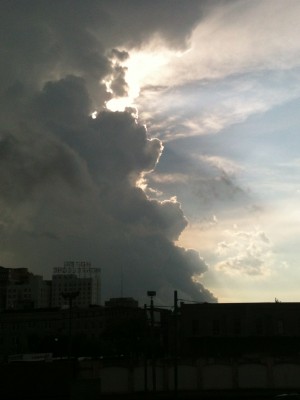Well, the food was out of this world, and we didn’t hold back. No problem, thinks James. All I need to do is put on my running shoes, leave the air conditioned frigidity of our hotel and do a standard six-miler. In the evening sun. In 90 degree heat. And 90 degree humidity. Ouch.
Ladies and gentlemen, I’m not proud, but this run almost finished me off. Anyone tech-savvy enough to download the .kml file behind this google map and interrogate the time signatures (geeeek!) will be able to work out that I ended up dragging my sorry ass round this embarrassingly short course in the world’s slowest time. I had visions of staggering into the hotel bar at run’s end like something out of Ice Cold in Alex and asking for a whisky sour and a litre of house saline (“warm water, one teaspoon salt, five of sugar and three straws please barman!”). I won’t say I burned off all the Jambalaya, but hell, I gave it my best shot.
I must admit that the heat wasn’t my biggest concern when I set out. New Orleans has had a relatively troubled past and as a result has some similarly troubled parts of town. The logical solution to a starting point in the French Quarter and a nice six mile loop takes an out-of-towner along the river, through the up-and-coming Marigny and into the Lower Ninth Ward.
For those of you who don’t know the city, Old New Orleans – the French Quarter, Bourbon Street etc. – was built on a natural levee on the curve of the Mississippi. More modern parts of town, for example the Lower Ninth, were built behind artificial levees about 10 feet below sea level, and as a result were … about 10 feet below sea level after Hurricane Katrina paid her visit in 2005.
Lucy and I both spent the majority of our waking hours over the past decade on the fringes of the (re)insurance industry, for which Hurricane Katrina was a Major Loss Event. Having seen the effects at a narrow industry-wide level, we thought it would be worth paying a visit to the Hurricane Katrina Museum, situated one floor below the Mardi Gras Museum – turn left at the artfully stranded boat by the cathedral.
Having always considered Katrina a natural disaster (hurricane – go figure) it was a surprise to me to hear it classified as man-made: to see exhibits detailing the mammoth but all too often counterproductive efforts undertaken by the federal flood protection programs over the years; to see clearly-explained design flaws in the levees themselves; and to see minute by minute dioramas of how and why they failed. After a room of hurricane tracks and a room of soil science, the rest of the museum focuses on the human cost and suffering of those in New Orleans at the time – those trapped in their homes and the tens of thousands suffering in the temporary shelter in the (Mercedes Benz sponsored) Superdome while the federal government struggled to help. It is pretty harrowing stuff.
A point that was made so carefully by the museum as to seem almost accidental was that 100,000 people remained in New Orleans … while 1.1 million reacted to the truly apocalyptic hurricane warnings and left town in a carefully orchestrated, pre-planned evacuation. That’s your eleven closest neighbors fleeing town, and you deciding to stay behind. And expecting the Federal Government (and there is a huge essay brewing somewhere in me about an Englishman’s take on the touchy relationship between the federal and state governments) to step in and helicopter you out.
I am not able to put myself in the minds of the people who stayed behind. Many may have lived through worse-sounding hurricanes. Many may not have been fortunate enough to have had places to go, or cars to take them there, or even money for petrol. Or may have been afraid of leaving their homes unprotected. In any event, those who stayed had their already tough lives made much, much tougher. All while the richer, older parts of the Big Easy remained relatively untouched above water level.
Returning to the possible route of my run, some said that the Lower Ninth Ward should never be rebuilt – that constructing a neighborhood well below sea level in a notorious hurricane zone may have been unfortunate once, but that doing it twice would count as carelessness. The people of New Orleans are made of tougher and brighter stuff, however, and the buildings have been reconstructed. That said, razing one of the city’s poorest areas to the ground and rebuilding it in a hurry has done nothing for the crime rate – I decided it wasn’t a place for an out of breath Englishman to be caught after dark, and kept my run shamefully short.

Worrying looking clouds at half time


